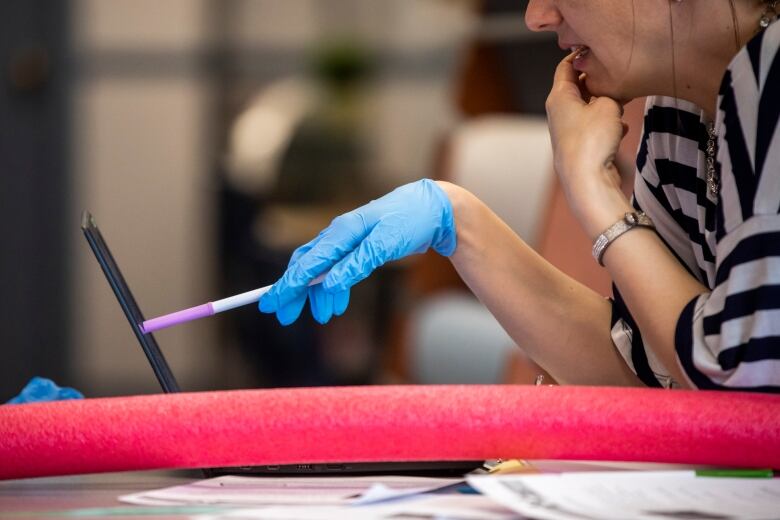The new normal: School for children of essential workers and a look at what the future may hold
No shared equipment, lots of hand sanitizer and reminders to 'stay in your bubble'

Asschools in B.C. work toward fully reopening next fall,5,000 studentsmost of them children of essential service workers have already been in the class for weeksand mayprovide a glimpse of what's ahead.
Foam pool noodles andhulahoops are used to remind kids about staying apart. And hand sanitizer sits on top of almost every desk in the hallways and classes where 33 of those childrenlearn and playat an Essential Service Workers Schoolin West Vancouver'sHollyburn Elementary School.
Theycome from all over the districtwhich normally teaches3,000 students in 14 elementary schools, now closed due to the COVID-19 pandemic.
Teachers thereare "building the airplane as they flyit," saysSandra-Lynn Shortall, the director of instruction for the West Vancouver school district.
"We've had to rebuild a school context within a very short period of time and we've had to support our children and families so we are doing our part during the global pandemic," Shortall said.
The school accepts children from ages five to 12 and is open from 7 am to 7 pm to accommodate theirparents' long working hours.
'Stay in your bubble'
With about aweek to prepare, Shortall says teachers needed to create more space for students to physicallydistance themselves from each other. The foyer of the school was transformed into a makeshift office and parents were directed to wave goodbye from the courtyard as their children entered the only entrance to thebuilding one by one.
"They are greeted by our receptionist who talks to them and does a really gentle health checkto ensure it's heathy children and adults coming into our school environment only,"Shortall said.
Kids wash theirhands before entering classrooms which arealso separated by empty rooms.
For every two educators, there area maximum ofeight children.

Walking through the hallways, onfloors now emblazonedwith colourful directional arrows and footsteps, Shortall reminds kids to "stay in their bubble."
"Everyone has their own learning space which includes theirown basket of learning materials, so there's no communal shared resources," Shortall says.
While thekids have adapted to air high fives and air hugsnow, kindergarten teacherFarah Babul says it was challenging when theyarrived about fourweeks ago.
"There weretears, getting used to routines of washing hands, not bursting each others bubbles and social distancing with teachers," Babul said.
About every week, one to two new children are welcomed into the school.
Across the province, similar classrooms inindependent and public schools areproviding education to 4,700 children offirst responders and health care workersand 300 special needsstudents that need extrasupport.
Tough transition
Babul said on top of the emotional and social pressures of the pandemic, the children had to get used to a new way of being in school, being away from their old friends and teachers, and meeting new ones.
Students at the school learn numeracy and literacy, but she says at the beginning it was a place for kids to have a sense of normalcy and the comfort of a routine.
For teachers, it's also been an adjustment.

"Even when you are handing out something it is a bit of a challenge, or even leaning over to try to help them with their printing, its really challenging," Babul added.
Babul is normally an English-language learner teacher, but now, at the new school, she's teaching kindergarten.
Julie deLaplantewasa French teacherbefore the pandemic and now she's helping Grade 3 studentswith remote online learning taught bytheir home school teachers.
"It's really hard to imagine all 30 of them being in a room again, unless there's a vaccine, it's hard to think of what September will look like,"deLaplante said.
Nottime to relax
Bit by bit some restrictions are slowly being lifted at some schools asthe Ministry of Education takes direction from public health authorities.
"This certainly is not a time to be complacent or relaxed, we have to follow the health and safety recommendations and above all make sure our children are safe during this time," said Shortall.
While drafting plans to ease some restrictions this school year,B.C. Premier John Hogan says B.C. is preparing for a possible full resumption of school by September.












_(720p).jpg)


 OFFICIAL HD MUSIC VIDEO.jpg)
.jpg)



























































































